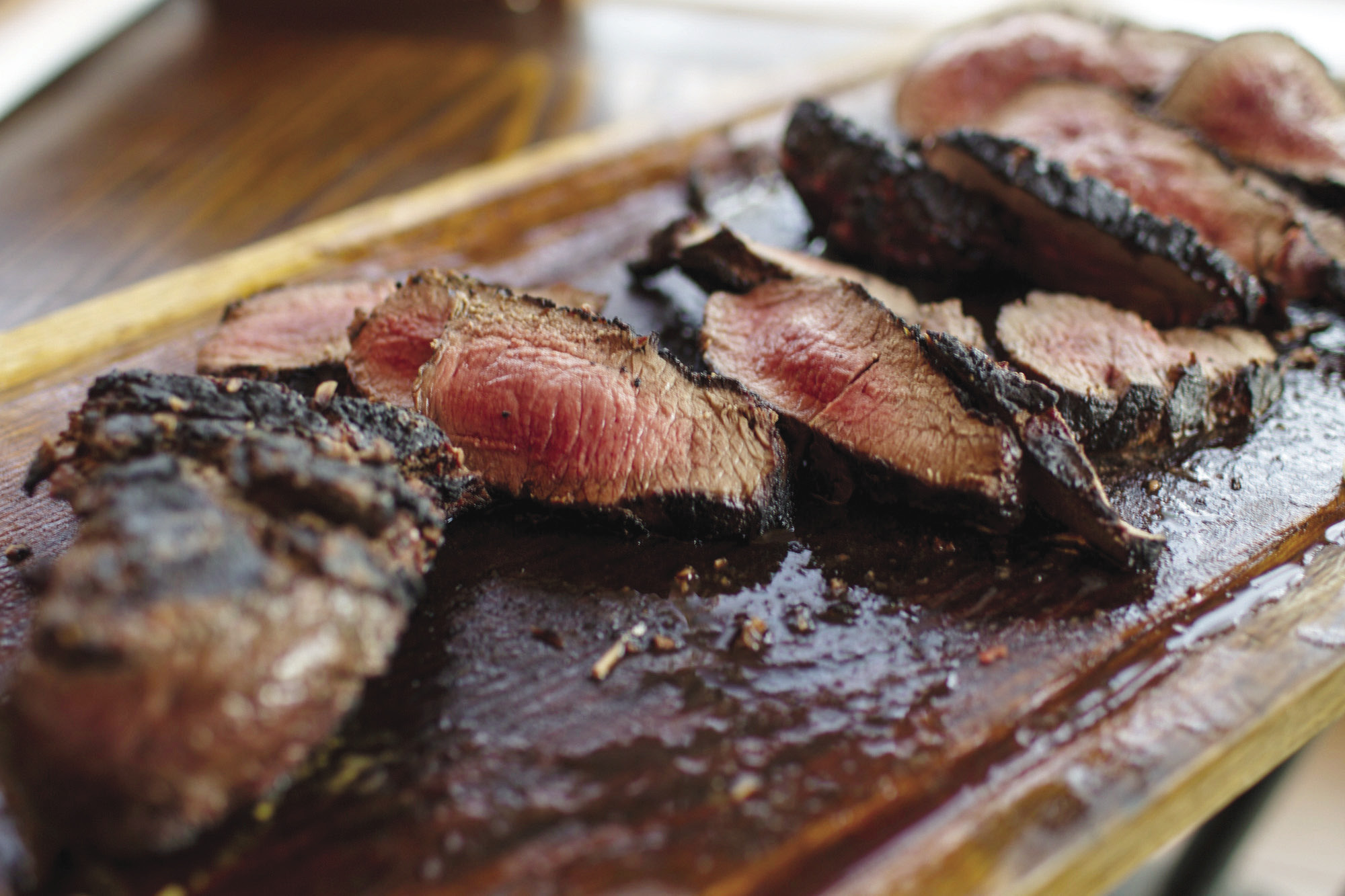The problem is that I really smell like human.
So says Peter Zander, the Upper East Side expat and professional photographer who decamped to the Hudson Valley, via Paris, two decades ago and last year began hosting deer-hunting workshop weekends on his 40 acres of woodlands up in Columbia County. Like me, most of his clients have never hunted. Their familiarity with free-range meats stems more from Whole Foods freezers than hours logged in a wobbly tree stand at dawn.
Zander, 56, didn’t grow up hunting, although his father probably taught you a thing or two about the topic. (Jack Zander was the first animator to work on Jerry, as in Tom and.) But Peter and his wife have spent much of their adult lives getting close to their food supply, raising rare breeds of poultry with their daughters and designing and selling solar-powered mobile chicken coops. Their red meat of choice is venison.
He explains that deer can smell people from a long way off, and suggests I pile on as many layers of his frumpy, aired-out sweaters as I can while still preserving vague arm mobility—at least enough to pull a trigger.
Once I’m swaddled in six hand-me-downs, Zander completes my chubby-kid-in-winter look with an old leather jacket and a bright-orange hunting vest before spritzing me with scent-masking spray for good measure. I scale the tree that hosts my stand, grip the hand-warmers tucked in every pocket, and face the wind, scanning the forest for movement, ready to fell a winter’s worth of dinner.
Stereotypes of hunting culture hew toward images of red-state burly men who prefer the NRA to the EPA. And while many hunters fit the type, Zander doesn’t. He’s not out for a trophy rack to hang above the fireplace, but for food to cook in it. Like the people who sign up for his weekend workshops—which take you from “Intro to Hunting” to “Venison Butchering” and cost from $250 to $950 per person—he hungers for the connective experience to the natural world that cannot be found in even the tenderest cut of grassfed beef. He says finding, killing and butchering the animal you’re going to eat is about as visceral an understanding as you can ask for.
Zander and his wife, Nancy, who serves participants the rustic, family-style locavore dinners you’d expect while tracking game with Martha Stewart, know that large swaths of the country, particularly suburban and exurban regions, are overrun with deer. The fragmented woodlands of low-density development (which deer actually prefer), a lack of predators and the abundant offerings of ornamental and vegetable gardens have brought about an explosion in deer numbers. Biologists cite the unchecked population as responsible for the spike in Lyme disease, predominantly spread by deer ticks.
Moreover, the calories in wild venison have a carbon footprint lower than even the best farmed meat—even pastured pork and poultry eat some grain (which requires tractors and trucks), are often kept safe from coyotes via electric fencing and otherwise tap the grid. Wild deer meat’s environmental impact may be lower than that of commercial vegetables.
“Everything we’ve been working toward is about connecting people to the environment and sustainable living,” Zander says. “Hunting gives you a better appreciation of your impact both as a consumer and as a participant in the world.”
In many ways, the Zander experience is the antithesis of bustling up to the butcher case to grab a shrink-wrapped sirloin. Don’t be fooled by notions of speeding bullets—this is about as slow as food gets. It takes time and a superlative level of stillness to even see a deer in the woods.
“When you get to the point of being in that really quiet place, that’s when you take your deer,” Zander says. “It’s kind of shocking when that gun goes off and that animal falls. If you haven’t reached that quiet place, you won’t see anything.”
“A lot of people think it’s just ‘Give me a gun and I’ll go shoot something,’” says Jon Veleas, a fellow photographer and longtime hunter who serves as a guide on Zander’s hunting trips. “That’s not the case at all.”
These gatherings aren’t testosterone-fueled affairs, explains the lanky, mild-mannered Zander, who shot his first deer decades ago. Instead, he sees the weekends as opportunities for people to participate in the intimate, hands-on experience of harvesting their own meat from the wild. Participants prepare a tree stand, spend time on target practice with their own gun and otherwise prepare for November 17, when deer season begins with the sunrise.
Zander and Veleas field-dress and butcher their deer, making a point of using every part of the animal. They’ve even been known to salvage meat from fresh roadkill. Zander’s Lab almost exclusively eats raw venison.
Zander’s favorite tree stand, 25 feet up in the air, boasts a nylon safety strap, one ledge for feet, a tinier ledge for a hunter’s butt and a sweeping view of a floodplain, bisected by a brook.
Shivering with the force of a pneumatic paint shaker, looking forward to hours more in a vertigo-inducing stand, I realize that hunting takes as much fortitude as force. Like many urbanites, I’ve often assumed modern hunters, with their sharpshooter equipment and paraphernalia, violate fair play with the ease of the kill. But any deer these hunters take are hard won.
“It’s the biggest and hardest chess game,” says Veleas, who, as an eight-year-old, saw his mother burst into tears after shooting her first deer.
For newcomers, the process will require dedication. Participants learn about the animal and its environment, and are guided through getting gun certification and a hunting license. Veleas, who grew up hunting in Connecticut and Vermont, spends a day teaching participants to recognize scrapes (places where bucks break or twist low branches, then paw the earth below and urinate to draw does) and rubs (marks on the trees from bucks rubbing the velvet off of their antlers, tagging the tree with their glandular scent and strengthening their neck muscles to fight for females). He also helps familiarize people with their tree stands and scent control.
Finally, new hunters will find themselves up a tree, gun in hand, scanning the woods for movement. Should they kill a deer, there will be the tasks of gutting, cleaning and curing, and then a final weekend spent skinning and butchering.
It’s a lot of effort, but it can result in months of meat. Venison is leaner than beef or pork and, if dressed and butchered right, it’s silky with only the slightest hint of gaminess.
This fall, Karl Kuhnen, an ironworker and former butcher who grew up on a farm, will teach Zander’s hunters how to properly butcher a deer. Knife skills are particularly important with venison: It’s the fat that can give venison an undesirable gaminess, and leaving the fat on can contaminate the entire carcass.
Still, Kuhnen wants his charges to not get preoccupied with the perfect cut. “Don’t be afraid,” he says, pointing out that hunters’ cuts aren’t destined for the butcher case. “You just have to get in there and do it!”
That said, he does offer a few words of caution, delivered with characteristic frankness: “Don’t puncture stuff that shouldn’t be punctured.”
Kuhnen says the backstrap, or tenderloin, is most people’s favorite cut. “Honestly, I like when my wife stews a part like the neck,” Kuhnen says. “She just throws it in the Crock-Pot for a day and a half.”
Nancy’s bacon and cheddar scone was a highlight of the morning I spent in my tree stand, where I was certain the chattering of my teeth was scaring away all nearby life forms. I saw no deer that morning, nor when I went out again at dusk, but despite that fact—or rather, because of it—I gained a deeper respect for hunting and the particular blend of skill and sheer luck it requires.
“A big part of hunting is about becoming so silent in the woods that you really for the first time see the life in the forest and the fields,” says Zander. “It’s the whole process and experiencing a day of real quiet. It’s so incredibly meditative.”
Photo credit: Peter Zander



